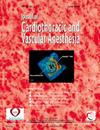有腔隙肺连接的麻醉患者机械通气对血流动力学的影响:一项生理交叉研究。
IF 2.1
4区 医学
Q2 ANESTHESIOLOGY
Journal of cardiothoracic and vascular anesthesia
Pub Date : 2025-07-31
DOI:10.1053/j.jvca.2025.07.037
引用次数: 0
摘要
目的:在单心室心脏和腔隙肺连接的患者中,肺部和全身的血液流动都依赖于通过肺部的被动静脉引流。传统观点认为,与正压机械通气相反,自发呼吸能提高这些患者的心输出量。然而,在全身麻醉下,自发与机械通气对血流动力学的影响还没有系统的研究。设计:前瞻性、交叉、单中心临床研究。地点:加州洛杉矶洛杉矶儿童医院心导管实验室。研究对象:35例经麻醉的肺腔吻合(Glenn或Fontan)患儿择期心导管置入术。干预措施:在两种情况下评估每位患者的血流动力学:自主呼吸和机械通气。采用混合线性模型对两种通气方法的血流动力学参数进行分析和比较,以调整潜在的混杂因素。测量结果及主要结果:自主呼吸时心脏指数明显升高(平均差值:0.6 L/min/m²,p = 0.022)。自发呼吸时心房压也较高(平均差值:1.9 mmHg, p < 0.001)。肺血管阻力、跨肺梯度、肺血流量与全身血流量之比(Qp:Qs)在不同通气方式间无显著差异。结论:与机械通气相比,在有气道安全的麻醉Glenn和Fontan患者中,自发通气可产生更好的血流动力学特征。目前的数据表明,心输出量的增加是由于全身心室预负荷的增加。这些结果应该指导围手术期通气管理和对该人群导管数据的解释。本文章由计算机程序翻译,如有差异,请以英文原文为准。
Hemodynamic Impact of Mechanical Ventilation in Anesthetized Patients With Cavopulmonary Connection: A Physiologic Crossover Study
Objectives
In patients with single-ventricle hearts and cavopulmonary connection, both pulmonary and systemic blood flow rely on passive venous drainage through the lungs. Conventional wisdom teaches that spontaneous breathing, as opposed to positive-pressure mechanical ventilation, enhances cardiac output in these patients. However, the hemodynamic effects of spontaneous versus mechanical ventilation under general anesthesia have not been systematically studied.
Design
A prospective, crossover, single-center clinical study.
Setting
The cardiac catheterization laboratory, Children’s Hospital Los Angeles, Los Angeles, California.
Participants
Thirty-five anesthetized children with cavopulmonary (Glenn or Fontan) anastomosis undergoing elective cardiac catheterization.
Interventions
Hemodynamics for each patient were assessed under each of two conditions: spontaneous breathing and mechanical ventilation. Hemodynamic parameters were analyzed and compared between the two ventilation methods using a mixed linear model to adjust for potential confounders.
Measurements and Main Results
Cardiac index was significantly higher during spontaneous breathing (mean difference: 0.6 L/min/m², p = 0.022). Atrial pressure was also higher with spontaneous breathing (mean difference: 1.9 mmHg, p < 0.001). Pulmonary vascular resistance, transpulmonary gradient, and the ratio of pulmonary to systemic blood flow (Qp:Qs) did not differ significantly between ventilation methods.
Conclusions
In anesthetized Glenn and Fontan patients with secured airways, spontaneous ventilation produces a superior hemodynamic profile compared with mechanical ventilation. The current data suggest that the enhanced cardiac output results from increased systemic ventricular preload. These results should guide perioperative ventilatory management and interpretation of catheterization data in this population.
求助全文
通过发布文献求助,成功后即可免费获取论文全文。
去求助
来源期刊
CiteScore
4.80
自引率
17.90%
发文量
606
审稿时长
37 days
期刊介绍:
The Journal of Cardiothoracic and Vascular Anesthesia is primarily aimed at anesthesiologists who deal with patients undergoing cardiac, thoracic or vascular surgical procedures. JCVA features a multidisciplinary approach, with contributions from cardiac, vascular and thoracic surgeons, cardiologists, and other related specialists. Emphasis is placed on rapid publication of clinically relevant material.

 求助内容:
求助内容: 应助结果提醒方式:
应助结果提醒方式:


